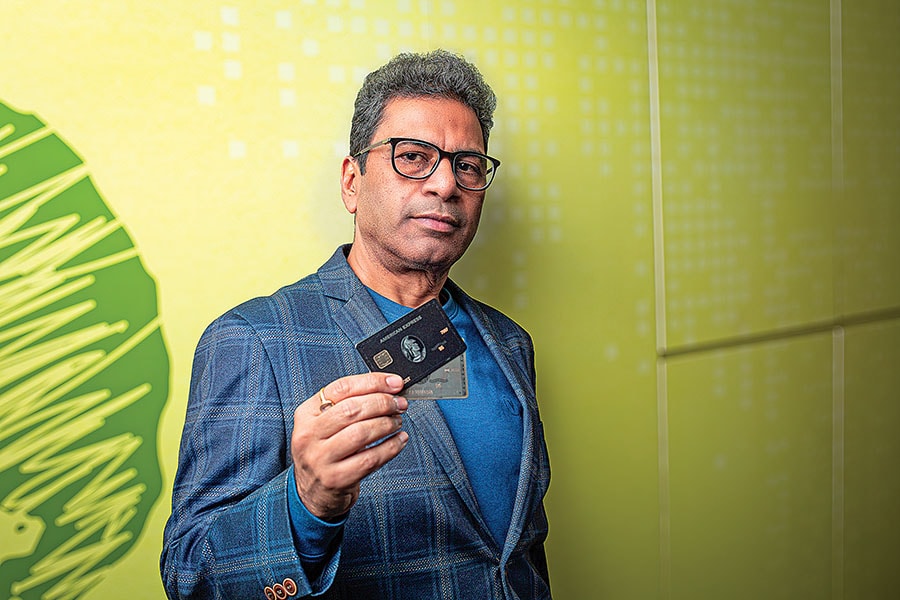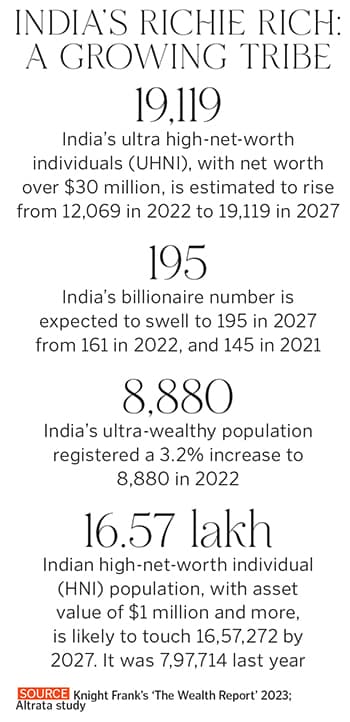
Money can't buy everything: Unpacking the allure of the invite-only American Express Centurion 'Black'
By Rajiv Singh| Nov 16, 2023
American Express is expanding the bouquet of its ultra-luxury and premium cards from top cities to smaller towns. The catch is that the jewel in the crown—the Centurion aka 'Black' card—is still strictly by-invite only
 [CAPTION]Sanjay Khanna, chief executive officer (CEO) and country manager of American Express Banking Corp, India.[/CAPTION]
[CAPTION]Sanjay Khanna, chief executive officer (CEO) and country manager of American Express Banking Corp, India.[/CAPTION]
Rohit Kumar has a black-and-white definition of luxury. “If everybody has it, then definitely it can’t be luxury,” smiles the 45-year-old businessman from Raipur, the capital city of Chhattisgarh. “It has to be exclusive, confined to a select few, and immensely aspirational,” says the real estate magnate, who ventured into mining and liquor over the last decade, expanded his business into neighbouring states, and added a Coupe Lamborghini Huracan Evo to his swelling stable of ultra-high end luxury cars last year.
_RSS_Well, Coupe was a coup for Kumar. “One can buy a Lamborghini, but how many can flaunt a Coupe,” asks Kumar, who flaunts the starting on-road price of Huracan Evo—Rs 3.7 crore—but declines to reveal his name for the interview. “You can call me Rohit Kumar. I don’t want to attract unnecessary attention,” avers the industrialist who grabbed the right kind of attention when he was invited to own American Express’ Centurion Card this year. One has to reportedly shell out $10,000 as a one-time joining fee to own a Black card, which has an annual fee of $5,000. “Now this is what I call luxury. You can’t buy this,” he says, flashing a smug smile. Centurion—popularly known as Black card—card holders can’t buy the card. It’s a by-invite club with a long waiting list, and no certainty that one will finally own the card. “This is the magic of Black card,” adds Kumar.
Back in Gurugram, Sanjay Khanna explains the alluring ‘Black’ magic, and the ingredients which make the Centurion card immensely aspirational. “Centurion is more than a card. It’s a way of life,” reckons the chief executive officer (CEO) and country manager of American Express Banking Corp, India. Centurion, underlines Khanna, offers the highest level of personalised benefits and services to its members. Decoding the characteristics of a Black card member, Khanna underlines that Centurion members are global citizens who travel extensively around the world for business and leisure. There is a dedicated Centurion relationship manager who happens to be an expert in travel and lifestyle. From helping the card holders get into the most sought-after restaurants to enabling access to the best entertainment across sports, music, theatre, art, and bespoke events, members enjoy exclusive service. But can Khanna share some specific examples of personalised services and benefits that card members enjoy in India? He delivers an enigmatic reply. “We don’t discuss or disclose its benefits,” he smiles. “To discover what it can offer, one must be invited to live the Centurion way of life.” 
Forbes India spoke to industry experts and analysts to decode the specifics of a Centurion way of life. The perks are indeed many. From complimentary access to over 1,400 airport lounges globally to discounts on international and national airlines, to especially designed luxury shopping experiences, including priority appointments with stylists and reservations at over 100 restaurants, Black card opens the gates to exclusivity and privileges. Members get a travel consultant and lifestyle concierge, and can redeem points that don’t come with an expiry date. There is a global air accident cover of Rs 10 crore, access to over 30 golf courses in India and over 50 international ones, and a complimentary overseas medical insurance of $250,000 for the first seven days of a trip.
Interestingly, Black—and a slew of other premium cards such as gold and platinum—has been slowly but steadily moving beyond the top cities. Kumar from Raipur exemplifies this trend of how luxury is finding a new set of users across the country. Khanna explains the shift. India’s affluent consumers, he underlines, have evolved rapidly over the last decade. “Tier 2 and 3 cities are contributing significantly to this growth,” he reckons. Deeper penetration of e-commerce, a heightened taste for luxury and rise in disposable incomes are driving the demand for premium products and a growing propensity to spend on credit cards across such cities and towns. “We are seeing demand coming from these places,” he says, adding that American Express has expanded its consumer acquisition from 15 to 50 cities across India. “Now, consumers are able to apply for our products digitally from anywhere.”
Also read: A home in London, a home in New York: Indian luxury real estate heats up to lure billionaires back
Though slowly, luxury is surely getting democratised in India. Its ultra high-net-worth individuals (UHNIs)—those with a net worth over $30 million—are estimated to rise from 12,069 in 2022 to 19,119 in 2027, according to Knight Frank’s latest wealth report. The high-net-worth individual (HNI) tribe, with asset value of $1 million and more, is also likely to increase from 7,97,714 last year to 16,57,272 by 2027.
Another report predicts a healthy rise in the number of billionaires, expected to expand to 195 in 2027 from 161 last year. “While I can’t give a number, we are definitely seeing more demand from tier 2 and 3 cities, owing to the increase in spending power and aspirations for premium in those cities,” claims Khanna. The rapidly evolving Indian consumers definitely have developed for a global luxury. Take, for instance, a steady rise in those flying to London. Bicester Village—a designer shopping centre outside Bicester, a town in Oxfordshire, England—gives Platinum Charge card members a crafted shopping experience with priority booking, hands-free shopping, personal stylist session and access to invitation-only luxury retreat, ‘The Apartment’. Premium, Khanna underlines, means different things for different segments. For the ultra-affluent, UHNIs, premium is reflected in exclusivity and access, while for others premium refers to the badge-value and the association of partnerships and offers brought by American Express.
Also read: Indian luxe chocolates are having a moment under the sun
American Express, say marketing and branding experts, has mastered the art of whipping up aspirations and hysteria around owning luxury cards. “By being hyper selective in offering memberships, the brand has kept the exclusivity intact,” says Ashita Aggarwal, professor of marketing at SP Jain Institute of Management and Research. The thumb rule of luxury, she says, is not diluting or lowering the exclusive benchmark. At times, snob value fuels the cult value of a brand. “The notion that ‘if you don’t have it, you haven’t arrived yet’ helps in maintaining the high aspirational quotient of the brand,” she says, adding that the brand has been smart in not being aggressive in letting more members inside the Black club. “The magic lies in the ‘pull’ and not in the ‘push’ which other brands resort to in order to beef up their numbers.” 
Khanna, for his part, avers that the Black card club is designed to remain selective, exclusive, and by-invite. “The Centurion way of life is destined to remain the way it is,” he signs off.